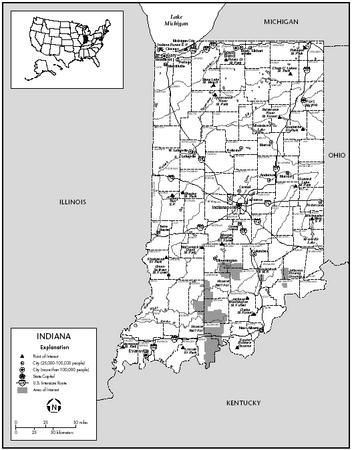Indiana
Environmental protection
During the 19th century, early settlers cut down much of Indiana's forests for farms, leaving the land vulnerable to soil erosion and flood damage, particularly in the southern part of the state. In 1919, the legislature created the State Department of Conservation (which in 1965 became the Department of Natural Resources) to reclaim worn-out soil, prevent further erosion, and control pollution of rivers and streams. In 1986 the Indiana Department of Environmental Management was initiated as a watchdog over the environmental laws and regulations designated to preserving the environmental well being of the state. Still, almost 85% of Indiana's original wetlands have been lost and, in 1997, it was estimated that the state continues to lose 1–3% of its remaining wetlands per year.
The Department of Natural Resources regulates the use of Indiana's lands, waters, forests, and wildlife resources. Specifically, the department manages land subject to flooding, preserves natural rivers and streams, grants mining permits and regulates strip-mining, plugs and repairs faulty/abandoned oil and gas wells, administers existing state parks and preserves and buys land for new ones, regulates hunting and fishing, and examines any damage to fish and wildlife by investigating industrial accidents. Also, the department is responsible for preventing soil erosion and flood damage, and for conserving and disposing of water in the state's watersheds.
The Indiana Department of Environmental Management (IDEM) seeks to protect public health through the implementation and management of various environmental programs. The focus of the environmental programs is to protect Indiana's air, land and water resources, since the proper management of these resources contribute to the health and well being of the citizens of Indiana. Prior to April 1986, these environmental programs were under the auspices of the State Board of Health (ISBH).
In addition to IDEM and the Department of Natural Resources the following boards exist to aid in environmental involvement: Air Pollution Control Board, Water Pollution Control Board, Pollution Prevention Control Board, and the Solid Waste Management Board.
In 1990, Indiana lawmakers passed landmark legislation that created an Office of Pollution Prevention and Technical Assistance within IDEM. OPPTA's long-term goal is to ensure that all Indiana industries use pollution prevention techniques as the preferred method for reducing waste and protecting the environment. This policy, along with programs that encourage reuse and recycling and discourage landfilling and incineration, will help conserve natural resources.
In March 1990, Indiana's Water Pollution Control Board adopted some of the strictest water quality standards in the nation. The standards set criteria for more than 90 chemicals and designated almost all water bodies for protection of aquatic life and recreational use. These standards will help improve and protect the quality of water in Indiana's lakes, rivers, and streams.
IDEM devotes much attention to identifying, cleaning up, and remediating all forms of toxic contamination. On 31 January 1986 the agency gained federal delegation for the Resource Conservation and Recovery Act (RCRA), which governs the generation, storage, treatment, transport, and disposal of all hazardous waste. Beyond RCRA, IDEM encourages companies to examine their production cycles and to adopt processes that won't create hazardous waste. The Department of Environmental Management offers technical assistance for the installation of pollution prevention equipment and encourages consumers to rethink their use and disposal of hazardous household goods and chemicals. When that waste is not properly handled and disposed of, expensive remediation is often required. In 2003, the Environmental Protection Agency's database listed 210 hazardous waste sites, 28 of which were on the National Priorities List, in Indiana.
Since IDEM was established in 1986, enforcement activity has increased fivefold. This is due, in part, to its unified Office of Enforcement, which consolidated enforcement staff who had been working separately in offices for air, solid waste, hazardous waste, and water. A key strategy in enforcement actions is to encourage violators to adopt pollution prevention practices or restore environmental damage as part of their penalty.
Some of the state's most serious environmental challenges lie in Lake and Porter counties in Northwest Indiana. A century of spills, emissions and discharges to the environment there require comprehensive, regionally coordinated programs. In 1991, IDEM opened a regional office in Gary to act as a liaison with local officials, concerned citizens, and industry. This office is helping drive the development of a comprehensive remediation plan, including the involvement of concerned citizens through the Citizen's Advisory for the Remediation of the Environment (CARE) committee. The Northwest Indiana Remedial Action Plan (RAP) is a three-phased program designed especially for the Grand Calumet River and the Indiana Harbor Ship Canal. Both waterways are heavily contaminated and, if left in their current state, would certainly degrade the waters of Lake Michigan, the primary source of drinking water for the Northwest Indiana area.
The RAP is a direct result of treaties of the International Joint Commission, a coalition formed to protect the waters between the United States and Canada.
IDEM now offers expertise and approval for voluntary cleanup plans. When a voluntary cleanup is completed properly, IDEM will issue a certificate of completion, and the governor will provide a covenant not to sue for further action involving the
